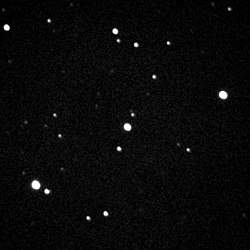WASP-1
Appearance
| Observation data Epoch 2000 Equinox 2000 | |
|---|---|
| Constellation | Andromeda |
| Right ascension | 00h 20m 40.077s[1] |
| Declination | +31° 59′ 23.79″[1] |
| Apparent magnitude (V) | 11.79 |
| Characteristics | |
| Spectral type | F7V[1] |
| Apparent magnitude (B) | ~12.0[1] |
| Apparent magnitude (V) | ~11.8[1] |
| Astrometry | |
| Proper motion (μ) | RA: -4.8 ± 2.3[1] mas/yr Dec.: -5.6 ± 2.3[1] mas/yr |
| Distance | 1239 ly (380 pc) |
| Absolute magnitude (MV) | 12.0 |
| Details | |
| Mass | 1.24 (± 0.17) M☉ |
| Radius | 1.382 (± 0.1) R☉ |
| Luminosity | 2.4 L☉ |
| Temperature | 6200 (± 200) K |
| Metallicity | 0.23 ± 0.08[2] |
| Other designations | |
| Database references | |
| SIMBAD | data |
WASP-1 is a metal-rich magnitude 12 star located about 1,240 light-years away in the Andromeda constellation.[2]
Planetary system
In 2006, an extrasolar planet was discovered by transit method of the SuperWASP.[3] The planet has a density of 0.31 to 0.40 g/cm3, making it about half as dense as Saturn, and one third as dense as water.
| Companion (in order from star) |
Mass | Semimajor axis (AU) |
Orbital period (days) |
Eccentricity | Inclination | Radius |
|---|---|---|---|---|---|---|
| b | 0.86 ± 0.07 MJ | 0.0382 ± 0.0013 | 2.5199464 ± 8e-07 | 0 | — | — |
References
- ^ a b c d e f g "SIMBAD query result: TYC 2265-107-1 -- Star". Centre de Données astronomiques de Strasbourg. Retrieved 2009-05-20.
- ^ a b Stempels, H. C.; et al. (2007). "WASP-1: a lithium- and metal-rich star with an oversized planet". Monthly Notices of the Royal Astronomical Society. 379 (2): 773–778. arXiv:0705.1677. Bibcode:2007MNRAS.379..773S. doi:10.1111/j.1365-2966.2007.11976.x.
{{cite journal}}: CS1 maint: unflagged free DOI (link) - ^ Cameron, A. Collier; et al. (2007). "WASP-1b and WASP-2b: two new transiting exoplanets detected with SuperWASP and SOPHIE". Monthly Notices of the Royal Astronomical Society. 375 (3): 951–957. arXiv:astro-ph/0609688. Bibcode:2007MNRAS.375..951C. doi:10.1111/j.1365-2966.2006.11350.x.
{{cite journal}}: CS1 maint: unflagged free DOI (link)
External links
- "WASP-1". Exoplanets. Retrieved 2009-05-20.
- Image WASP 1
See also

